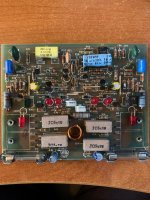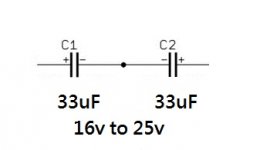I have a couple of original Sumo Polaris amps which are over 30 years old. I would like some suggestions on what capacitors I should and shouldn't change. I just replaced all the capacitors in a Sumo Athena. I also purchased identical spec power supply capacitors for the Polaris (Nichicon Super Through). However, some of the capacitors for the amp's PCB I can not find replacements with identical specs. For example the C9 (Culver, 16 uF - 50vdc - NP). Would it be alright to go higher in capacitance on that capacitor? My guess is it would not be ideal. I would also like suggestions on brand and types of replacements. I don't mind doing slight modifications either if it will result in better sonics and open to all suggestions. I am looking for the best possible replacements. I care about the amplifier as its been in my family for a long time. Thank you!
Attachments
Without a schematic it's like looking into the glass sphere... C9 might (!) be in the feedback-loop, so changing to another capacitance could (!) change the behaviour significantly.
But didn't the old rule say "If it's ain't broken don't fix it!"?
But if it is to fight against boredom... Change C7 and C3 against something new. Same with C14 and his brother at the lower end of the board. Panasonic FC or something like that with not to extreme low ESR as I would say without having a schematic. Maybe you could also change the pots against some with 25 turns and sealing against dust to make it more reliable over time and easier to adjust...
But didn't the old rule say "If it's ain't broken don't fix it!"?
But if it is to fight against boredom... Change C7 and C3 against something new. Same with C14 and his brother at the lower end of the board. Panasonic FC or something like that with not to extreme low ESR as I would say without having a schematic. Maybe you could also change the pots against some with 25 turns and sealing against dust to make it more reliable over time and easier to adjust...
Last edited:
C9 sees very small voltages as its in the DC servo, and you can replace with a larger value, that just slows the DC servo a bit. Theoretically it should be NP, but the small signal voltages it sees mean its not crucial
30 years old, replace all the electrolytics as a matter of course, give it another 30+ years rather than wait for problems which could destroy other parts.
30 years old, replace all the electrolytics as a matter of course, give it another 30+ years rather than wait for problems which could destroy other parts.
C9 sees very small voltages as its in the DC servo, and you can replace with a larger value, that just slows the DC servo a bit. Theoretically it should be NP, but the small signal voltages it sees mean its not crucial
30 years old, replace all the electrolytics as a matter of course, give it another 30+ years rather than wait for problems which could destroy other parts.
I found these capacitors. They are about $9 each so I wanted to get some feedback before buying. They general purpose capacitors so I am not sure if they will be best suited for audio. Would these capacitors work or should I look else where? If not these could I opt for a radial capacitor instead of an axial? Thank you!!
Manufacturer:Cornell Dubilier
Product Category:Aluminum Electrolytic Capacitors - Axial Leaded
RoHS: Details
Product:General Purpose Electrolytic Capacitors
Termination Style:Axial
Capacitance:16 uF
Voltage Rating DC:150 VDC
Tolerance:20 %
Ripple Current:45 mA
Minimum Operating Temperature:- 40 C
Maximum Operating Temperature:+ 85 C
Diameter:10.16 mm
Length:25 mm
Life:2000 Hour
Series:WBR
Packaging:Bulk
Type:Industrial Grade, Axial Leaded, Aluminum Electrolytic Capacitor
Brand:Cornell Dubilier - CDE
ESR:19.5 Ohms
Leakage Current:20 uA
Lead Style:Straight
Product Type:Electrolytic Capacitors
Factory Pack Quantity:25
Subcategory:Capacitors
C9 used in the DC output servo control circuit, it should be a bipolar cap, the value can be from 0.47uF to 10uf or like this amp using 16uF.
C9 is not in the signal path so that you can use normal price cap, or like some other commercial amp use two polar caps to make a bipolar cap. New electrolytic caps are smaller in size, so that it does not necessary to use an axial leaded cap, normal cap can put in the PCB is just ok.
Like using two 33uF(must double bipolar cap value) voltage form 16v to 25V is ok to make the bipolar cap, connection like the pic.
C9 is not in the signal path so that you can use normal price cap, or like some other commercial amp use two polar caps to make a bipolar cap. New electrolytic caps are smaller in size, so that it does not necessary to use an axial leaded cap, normal cap can put in the PCB is just ok.
Like using two 33uF(must double bipolar cap value) voltage form 16v to 25V is ok to make the bipolar cap, connection like the pic.
Attachments
Last edited:
C9 used in the DC output servo control circuit, it should be a bipolar cap, the value can be from 0.47uF to 10uf or like this amp using 16uF.
C9 is not in the signal path so that you can use normal price cap, or like some other commercial amp use two polar caps to make a bipolar cap. New electrolytic caps are smaller in size, so that it does not necessary to use an axial leaded cap, normal cap can put in the PCB is just ok.
Like using two 33uF(must double bipolar cap value) voltage form 16v to 25V is ok to make the bipolar cap, connection like the pic.
That's awesome. Great information. Thanks!
- Status
- This old topic is closed. If you want to reopen this topic, contact a moderator using the "Report Post" button.
- Home
- Amplifiers
- Solid State
- Sumo Polaris: What capacitors should be replaced?

